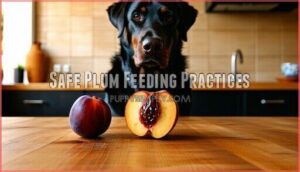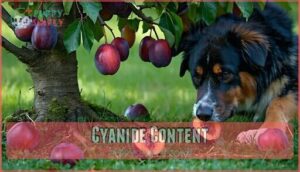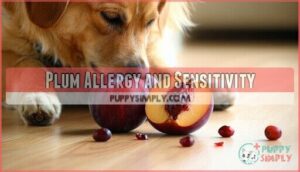This site is supported by our readers. We may earn a commission, at no cost to you, if you purchase through links.

The fruit itself won’t harm your pup, but plum pits contain cyanide compounds that can be deadly.
Even without swallowing the pit, the choking hazard and potential for intestinal blockage make plums a poor snack choice.
If your dog accidentally munches on plum flesh, don’t panic—just remove any remaining fruit and watch for unusual symptoms.
There are much safer fruit alternatives that’ll satisfy your dog’s sweet tooth without the dangerous pitfalls that come with this seemingly innocent stone fruit.
Table Of Contents
- Key Takeaways
- Can Dogs Eat Plums
- Dogs Eating Plums Safely
- Plum Nutrition Benefits
- Risks of Plum Consumption
- Safe Plum Feeding Practices
- Plum Pit Toxicity
- Alternatives to Plums
- Plum Allergy and Sensitivity
- Feeding Plums to Puppies
- Emergency Actions for Plum Poisoning
- Frequently Asked Questions (FAQs)
- Can dogs eat plums?
- What happens if a dog eats a plum pit?
- Can dogs eat plums & grapes?
- What if my dog ate a plum tree?
- How do you get a dog to eat a plum pit?
- Can dogs eat pears?
- Can dogs eat plums without the seed?
- Are plums good for my dog?
- Can dogs eat dried plums or prunes?
- Are plum tree leaves toxic to dogs?
- Conclusion
Key Takeaways
- You can give your dog plum flesh in tiny amounts, but it’s not worth the risk – while the fruit itself won’t poison your pup, the dangers from pits make safer alternatives a smarter choice.
- Plum pits contain deadly cyanide compounds – these hard stones can cause choking, intestinal blockages, and potentially fatal poisoning even in small amounts.
- Remove all pits, stems, and leaves completely before offering any plum flesh – these parts are toxic and dangerous, so proper preparation is essential if you choose to share this risky treat.
- Choose safer fruit alternatives like apples, blueberries, or bananas – these options provide similar nutritional benefits without the serious health risks that come with plums.
Can Dogs Eat Plums
Yes, dogs can eat plums, but only the flesh and with extreme caution.
The sweet fruit offers plum benefits like fiber and vitamins for dog nutrition, but plum toxicity dogs face comes from pits, stems, and leaves containing deadly cyanide.
Sweet plums pack nutrients but deadly pits contain cyanide – remove all dangerous parts before sharing.
Plum pits dogs accidentally swallow can cause poisoning or blockages.
For canine health and pet wellness, fruit safety requires removing all dangerous parts.
Most vets recommend safer alternatives since plums for dogs carry unnecessary risks.
Dog plum safety depends entirely on proper preparation and moderation.
Dogs Eating Plums Safely
How can you safely share plums with your furry friend? Plum safety requires careful preparation and moderation.
Remove all pits, stems, and leaves before offering any plum flesh to prevent plum toxicity dogs face from cyanide exposure. Cut the flesh into small, bite-sized pieces appropriate for your dog’s size.
Dogs eating plums should only receive the flesh as an occasional treat, not a regular meal component. Always supervise your pet during feeding and monitor for any adverse reactions.
When in doubt, consider safer fruit alternatives like apples or blueberries for pet wellness and canine health. Understanding plum fiber content is vital for maintaining a balanced diet for your dog.
Plum Nutrition Benefits
When you’re wondering about the nutritional value of plums for your dog, you’ll find they contain several beneficial nutrients that can support your pet’s health.
The flesh of properly prepared plums offers fiber, vitamins A and C, potassium, and antioxidants that may contribute to your dog’s overall well-being when given as an occasional treat.
Fiber and Vitamin Content
Fresh plums pack impressive nutritional value that benefits your dog’s health. The flesh contains dietary fiber and vitamins A and C, supporting healthy digestion and immune function.
However, plum toxicity dogs face comes from pits, not the fruit itself. Understanding plum fiber content is essential for dog owners to provide a balanced diet.
Fiber Benefits include:
- Promoting smooth bowel movements and digestive regularity
- Supporting healthy gut bacteria for ideal intestinal health
- Helping regulate blood sugar levels naturally
- Contributing to your dog’s feeling of fullness after meals
Antioxidant Properties
What makes plums a nutritional powerhouse for your pup?
These juicy fruits pack antioxidant properties that combat free radicals and reduce oxidative stress in your dog’s system.
The polyphenol content, alongside vitamins A and C, delivers impressive antioxidant benefits that support your dog’s immune system naturally.
However, these dog nutritional benefits only shine when you’ve properly removed all toxic parts first, ensuring the immune system is supported safely.
Hydration and Digestion
Plums pack a hydration punch that keeps your dog’s system running smoothly.
The high water content supports proper Water Intake while boosting Nutrient Absorption throughout their body.
Meanwhile, the natural Fiber Benefits work behind the scenes to maintain Digestive Health and promote healthy Gut Balance.
This winning combination enhances canine nutrition by supporting ideal gastric function—just remember to remove those dangerous plum pits first.
Risks of Plum Consumption
While plums can offer nutritional benefits when properly prepared, they pose several serious risks that you need to understand before sharing them with your dog.
The most dangerous threats include cyanide poisoning from pits, choking hazards, and potentially life-threatening intestinal blockages.
Cyanide Poisoning
Beyond the nutritional benefits, plum pits pose serious dangers through cyanide poisoning. The amygdalin in plum pits converts to hydrogen cyanide when chewed, creating a toxic emergency that’s particularly dangerous for dogs.
Toxicity Symptoms include:
- Bright red gums and dilated pupils
- Rapid breathing and hyperventilation
- Tremors, seizures, and collapse
- Cherry-red mucous membranes indicating Cyanide Exposure
Fatal Ingestion can occur within hours without immediate Emergency Response and Poison Control intervention. It’s vital to understand plum toxicity risks to guarantee dog safety and well-being.
Choking Hazards
Beyond toxicity concerns, plum pits pose serious choking dangers for dogs. These hard stones can lodge in your dog’s throat, blocking their airway and creating a life-threatening emergency.
Pit removal becomes critical before offering any plum flesh to prevent aspiration hazards. Dogs can benefit from understanding the plum safety guidelines to guarantee a healthy snack.
| Dog Size | Choking Risk Level |
|---|---|
| Small (2-30 lbs) | Extremely High |
| Medium (31-50 lbs) | High |
| Large (51-90 lbs) | Moderate |
| Extra-Large (91+ lbs) | Low-Moderate |
Even large dogs can struggle with plum pits due to their irregular shape and hard texture. The stones can become wedged in the digestive tract, creating obstruction symptoms that require immediate veterinary intervention.
Intestinal Blockages
Beyond choking risks, plum pits create serious intestinal blockages that can be life-threatening.
These hard stones can lodge anywhere in your dog’s digestive tract, causing gastrointestinal obstruction.
Watch for blockage symptoms like vomiting, loss of appetite, and abdominal pain.
Bowel issues and digestive problems often require immediate surgery.
Intestinal damage from gut obstruction can lead to severe complications if untreated.
Safe Plum Feeding Practices
While plums can provide nutritional benefits to dogs, proper preparation is essential to prevent serious health risks.
You’ll need to follow specific guidelines for pit removal, portioning, and feeding frequency to keep your pet safe, ensuring that you provide a safe and healthy experience for your dog through proper preparation.
Removing Pits and Stems
Before serving plums to your dog, you’ll need to handle the pit removal and stem cutting carefully.
Always wash the fruit thoroughly, then slice away from the center to avoid any pit fragments. Remove the stem completely—it’s part of the toxicity prevention process.
This fruit preparation step eliminates choking hazards and prevents plum dog poison risks from toxic plums dogs might encounter.
Using a plum pit remover can be an effective tool in the preparation process.
Portion Guidelines
Your dog’s size determines their Daily Allowance. Extra-small dogs (2-20 lbs) need 1-2 small pieces, while large dogs (51-90 lbs) can handle 7-8 pieces.
Think teaspoon-sized Serving Size for smaller pups, tablespoon amounts for medium breeds.
These Nutrient Limits prevent digestive upset while ensuring proper portion control. Always stick to these dog portion sizes for safe preparation and moderation.
Feeding Frequency
Occasionally offering plums as treats works best for your dog’s health and safety.
Limit plum feeding to every other day or a couple of times a week to maintain proper portion control.
This feeding frequency prevents digestive upset while allowing your pet to enjoy the nutritional benefits.
Remember, treats should never exceed 10% of your dog’s daily intake, so moderation remains key for balanced meal frequency and treat limits, ensuring proper portion control.
Plum Pit Toxicity
Understanding plum pit toxicity is essential for every dog owner since these seemingly innocent pits contain cyanogenic glycosides that release deadly cyanide when chewed or digested.
Even small amounts can cause rapid poisoning, making this knowledge potentially life-saving for your furry friend.
Cyanide Content
Plum pits pack a dangerous punch in regards to cyanide content. These seemingly innocent stones contain amygdalin, a compound that breaks down into hydrogen cyanide when chewed or crushed, creating serious pet safety concerns.
Those innocent-looking plum pits hide a deadly secret—cyanide that releases when crushed.
Dog owners should be aware of the risks associated with plum poisoning symptoms to take prompt action in case of an emergency.
Cyanide Content in Plum Pits:
- Toxicity Levels – Plum pits contain 35.6-253 µg/g of cyanide, with wild varieties averaging 162 µg/g
- Toxic Effects – Symptoms can occur at just 0.5 mg/kg of body weight in dogs
- Fruit Risks – Chewing or crushing pits releases more cyanide than swallowing whole pits
- Cyanide Poison – The kernel inside the pit contains the highest concentration of toxic compounds
- Plum Poisoning – Variety, growing conditions, and fruit maturity affect cyanide levels substantially
Ingestion Symptoms
After ingesting plum pits, watch for vomiting signs and toxic reactions within hours.
Cyanide poisoning causes digestive issues like vomiting, diarrhea, and abdominal pain.
Your dog might show poison symptoms including drooling, difficulty breathing, and lethargy.
These emergency care situations demand immediate attention since toxic reactions can escalate quickly, turning a sweet treat into a serious health crisis.
Emergency Procedures
When plum pit ingestion occurs, time becomes your greatest ally in preventing serious complications.
Contact your veterinarian immediately or call the ASPCA Poison Control Center at (888) 426-4435.
Don’t induce vomiting unless specifically instructed by veterinary professionals, as this can worsen cyanide poisoning.
Emergency medical attention is essential since toxic symptoms can escalate rapidly in dogs, making immediate action crucial.
Alternatives to Plums
If you’re concerned about plum risks, plenty of safer fruit alternatives can satisfy your dog’s sweet tooth.
Veterinarians recommend options like apples (without seeds), blueberries, and bananas that provide similar nutritional benefits without the toxicity concerns.
Safe Fruits for Dogs
Several safer fruit alternatives provide excellent nutrition without the risks associated with plums.
These options offer peace of mind while satisfying your dog’s sweet tooth and supporting their overall health. Understanding dog safe food options is essential for their well-being.
- Apples (seedless): Crunchy, fiber-rich slices that clean teeth naturally
- Blueberries: Antioxidant powerhouses perfect for training treats
- Bananas: Potassium-packed energy boosters in bite-sized pieces
- Watermelon: Hydrating summer refreshment without seeds or rind
- Strawberries: Vitamin C-rich gems that most dogs absolutely love
Berry Benefits
Berries pack a nutritional punch that makes them excellent alternatives to plums for dogs.
Unlike stone fruits, berries won’t pose choking hazards or toxicity risks from pits.
| Berry Type | Antioxidant Effects | Key Nutrients | Serving Size |
|---|---|---|---|
| Blueberries | High anthocyanins | Vitamin C, fiber | 2-10 berries |
| Strawberries | Vitamin C boost | Folate, potassium | 1-3 berries |
| Blackberries | Anti-inflammatory | Manganese, vitamin K | 2-5 berries |
| Raspberries | Heart-healthy | Fiber, ellagic acid | 2-5 berries |
These healthy snacks offer superior nutrient value compared to riskier stone fruits, making berry advantages clear for safe fruit consumption.
Other Fruit Options
Beyond berries, you’ve got plenty of Apple Benefits to explore—they’re packed with fiber and vitamin C when you remove those pesky seeds.
Mango Safety is solid too, offering tropical sweetness in small portions.
These safe fruits for dogs beat risky stone fruits every time, making them a great choice with several benefits.
Plum Allergy and Sensitivity
While most dogs can safely eat properly prepared plum flesh, some may experience allergic reactions or sensitivities to this fruit.
You’ll want to watch for signs like itching, digestive upset, or unusual behavior after your dog’s first taste of plum, to identify potential sensitivities.
Signs of Allergic Reaction
While safer fruit alternatives exist, you’ll need to watch for specific allergy symptoms if your dog has eaten plum flesh.
Food sensitivity in dogs can manifest through various physical signs that require immediate attention.
Here are key reaction signs to monitor:
- Skin reactions – hives, swelling of face or lips, excessive dog itching
- Respiratory distress – difficulty breathing, heavy panting, foaming at mouth
- Gastrointestinal upset – dog vomiting, diarrhea, loss of appetite
- Neurological symptoms – tremors, seizures, weakness or collapse
- Mucosal changes – brick-red gums, excessive drooling, watery eyes
Canine hypersensitivity to plums is rare, but these dog allergic reaction signs can escalate quickly, requiring immediate veterinary care.
Monitoring for Sensitivity
Watch your dog closely after feeding plums for any sensitivity signs like digestive issues, vomiting, or unusual behavior.
Monitor nutrient tolerance by starting with tiny amounts and tracking reactions over 24-48 hours.
Dogs eating plums may show delayed responses, so keep notes about plum consumption timing and symptoms.
Even small sensitivity reactions warrant careful reaction monitoring.
Consultation With Veterinarian
When you notice signs of sensitivity after feeding plums, professional veterinary advice becomes your best ally.
Your veterinarian can assess your dog’s specific health needs and provide personalized guidance about introducing new foods safely.
- Schedule a vet consultation before adding plums to dogs with existing health conditions
- Discuss pet nutrition plans that accommodate your dog’s dietary restrictions or allergies
- Get veterinarian advice on proper portion sizes based on your dog’s weight and health status
- Consider pet nutritionist recommendations for balanced treat alternatives if plums aren’t suitable
Feeding Plums to Puppies
Puppies have developing digestive systems that make them more vulnerable to plum-related toxicity than adult dogs.
You should avoid giving plums to puppies under 12 months old, as their smaller size increases choking risks and their immature systems can’t process potential toxins as effectively, which is a significant concern for their digestive systems.
Nutritional Needs
Growing puppies require twice the protein and calories of adult dogs to fuel their rapid development.
Their dog nutrition needs differ substantially from mature canines, making nutrient balance essential for healthy growth.
When considering safe fruits for dogs like plums, you’ll want to prioritize their core nutritional needs first.
Puppies need consistent dog dietary needs met through high-quality puppy food rather than relying on healthy snacks.
| Nutritional Component | Puppy Requirement | Adult Dog Requirement |
|---|---|---|
| Protein (dry matter) | 22.5% minimum | 18% minimum |
| Fat content | 8.5% minimum | 5.5% minimum |
| Feeding frequency | 3-4 times daily | 1-2 times daily |
| Caloric density | Higher per pound | Standard maintenance |
Their developing digestive systems handle new foods differently, making dog digestive health monitoring essential when introducing any treats.
Pet diets should focus on complete nutrition rather than supplemental fruits.
Food allergies can develop more easily in puppies, so gradual introduction becomes imperative for their long-term health.
Potential Risks
While puppies can handle plum flesh in tiny amounts, they face heightened risks compared to adult dogs.
Their smaller bodies mean even minimal toxic exposure can cause severe reactions. Puppies are naturally curious and might swallow dangerous parts before you can intervene.
Key risk factors for puppies include:
- Higher toxicity levels – Cyanide poisoning from plum pits affects puppies more severely due to their lower body weight
- Increased choking hazard – Small airways make puppies more vulnerable to obstruction from plum pieces
- Digestive issues – Developing digestive systems can’t handle fruit sugars as efficiently, leading to diarrhea or stomach upset
Watch for dog symptoms like excessive drooling, difficulty breathing, or lethargy. Emergency response requires immediate veterinary attention if your puppy shows any concerning signs after plum exposure.
Emergency Actions for Plum Poisoning
If your dog shows signs of plum poisoning like vomiting, lethargy, or difficulty breathing, contact your veterinarian immediately—cyanide toxicity can be fatal without prompt treatment.
While waiting for professional help, keep your dog calm and don’t induce vomiting unless specifically instructed by a vet, as this can worsen the situation, due to the risk of fatal outcomes.
Symptoms of Poisoning
When plum poisoning strikes, your dog’s body sends clear distress signals.
You’ll spot bright red gums, rapid breathing, and dilated pupils as cyanide effects take hold.
Vomiting, excessive drooling, and tremors follow quickly.
These toxicity signs can escalate to collapse within hours, making emergency care essential for plum poisoning cases.
Contacting a Vet
When your dog shows signs of cyanide poisoning, immediate veterinary consultation becomes your lifeline.
Don’t hesitate to contact your veterinarian or emergency animal hospital right away.
Here’s your action plan:
- Call your vet immediately – explain the plum ingestion and symptoms
- Contact pet poison control – they provide 24/7 phone advice
- Have your pet insurance info ready – speeds up emergency processing
- Document symptoms – helps veterinary staff assess severity quickly
Time’s critical with dog poisoning cases.
Immediate Care Procedures
Time’s your lifeline when facing plum poisoning.
Don’t induce vomiting unless your vet specifically instructs you to. Remove any remaining plum pieces from your dog’s mouth if safely possible.
Call Poison Control or your emergency vet immediately for guidance on toxicity treatment.
Monitor breathing, consciousness, and symptoms while rushing to professional care for proper emergency response.
It’s vital to understand the importance of proper plum poison treatment procedures in such situations.
Frequently Asked Questions (FAQs)
Can dogs eat plums?
Back in medieval times, knights wouldn’t share their feast with hounds, but today’s pet parents wonder about plums.
You can offer your dog small pieces of plum flesh occasionally, but always remove the toxic pit first—it contains cyanide that’s dangerous.
What happens if a dog eats a plum pit?
If your dog swallows a plum pit, it’s a serious emergency requiring immediate veterinary attention.
The pit contains cyanide, which is highly toxic and potentially fatal.
It can also cause choking or dangerous intestinal blockages.
Can dogs eat plums & grapes?
Like knights of old protecting their castle, you must guard your pup from grapes—they’re toxic and can cause kidney failure.
Only properly prepared plum flesh is safe in tiny amounts.
What if my dog ate a plum tree?
If your dog ate plum tree parts, contact your veterinarian immediately. Bark, leaves, stems, and pits contain toxic compounds causing cyanide poisoning. Watch for vomiting, difficulty breathing, and lethargy.
How do you get a dog to eat a plum pit?
You shouldn’t encourage your dog to eat plum pits—they’re toxic and potentially fatal. Plum pits contain cyanide compounds that cause poisoning, choking hazards, and intestinal blockages requiring emergency surgery.
Can dogs eat pears?
Yes, dogs can safely eat pears.
Remove seeds and core first, as they contain cyanide compounds.
The flesh provides fiber, vitamins, and hydration. Offer small pieces as occasional treats, not daily meals.
Can dogs eat plums without the seed?
You can safely feed your dog plums without the seed, but only tiny portions of flesh. Remove pits, stems, and leaves completely—they’re toxic and dangerous for dogs.
Are plums good for my dog?
Plums offer vitamins A, C, and fiber that benefit your dog’s health.
They’re risky treats, but can be given if prepared correctly.
You must remove pits, stems, and leaves completely—they contain cyanide and cause choking.
Feed only small flesh pieces occasionally.
Can dogs eat dried plums or prunes?
Looking at dried plums is like opening Pandora’s box—you’re releasing concentrated sugar and potential digestive chaos.
Don’t give your pup prunes; they’re harder to digest than fresh plums and can cause serious stomach upset and diarrhea.
Are plum tree leaves toxic to dogs?
Plum tree leaves contain toxic compounds that can poison your dog.
The stems, leaves, and bark all pose serious health risks, potentially causing cyanide poisoning.
Keep your pup away from plum trees entirely.
Conclusion
While you might think plums are just another harmless fruit, the risks far outweigh any benefits regarding your dog’s safety.
The question "can dogs eat plums" has a clear answer: avoid them entirely.
The flesh won’t kill your pet, but the cyanide-containing pits create serious dangers including choking, intestinal blockages, and potential poisoning.
Skip the worry and choose safer alternatives like apples, blueberries, or bananas that’ll satisfy your dog’s cravings without the deadly risks lurking inside every plum.
- https://fdc.nal.usda.gov/fdc-app.html
- https://www.nutritionvalue.org/Plums%2C_raw_nutritional_value.html
- https://www.aspca.org/pet-care/animal-poison-control/toxic-and-non-toxic-plants/plum
- https://nap.nationalacademies.org/resource/10668/dog_nutrition_final_fix.pdf
- https://www.fda.gov/consumers/consumer-updates/paws-xylitol-its-dangerous-dogs



















